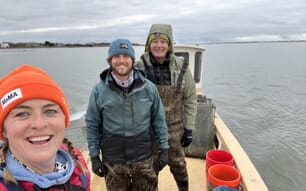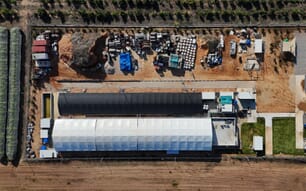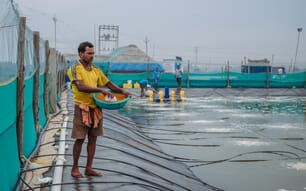Ponds
Pond culture of tilapia is conducted with a variety of inputs such as agricultural by-products (brans, oil cakes, vegetation and manures), inorganic fertilisers and feed.
Annual fish yields using tilapia in polyculture with carps, high levels of agricultural by-products and good stock management can reach or exceed five tonnes/ha.
In monoculture tilapia systems, animal manures provide nutrients that stimulate the growth of protein-rich phytoplankton, which is consumed by filter feeding Nile tilapia. The nutrient content of manures varies. Water buffalo manure has much lower nutrient levels compared to duck and chicken manure.
Obtaining sufficient nutrient levels from manures poses a danger of oxygen depletion from excessive loading of organic matter. Therefore, a combination of manures with inorganic fertilisers is used in low-input production systems.
In Thailand, applying chicken manure weekly at 200-250 kg DM (dry matter)/ha and supplementing it with urea and triple super phosphate (TSP) at 28 kg N/ha/week and 7 kg P/ha/week produces a net harvest 3.4-4.5 tonnes/ha in 150 days at a stocking rate of 3 fish/m² or an extrapolated net annual yield of 8-11 tonnes/ha.
Similar yields are obtained solely with inorganic nutrients if alkalinity, a source of carbon, is adequate.
In Honduras yields of 3.7 tonnes/ha are obtained at a stocking rate of 2 fish/m2 with weekly application of chicken litter at 750 kg DM/ha and urea at 14.1 kg N/ha.
There is sufficient natural phosphorus. Fertilisation strategies produce fish to a size of 200-250 g in five months. Formulated feeds are necessary to produce larger fish and obtain a higher market price.
To reduce production costs for domestic markets in developing countries, two strategies are followed: delayed feeding and supplementary feeding.
In Thailand, tilapia are stocked at three fish/m2 and grown to 100-150 g in about three months with fertiliser alone, and then given supplemental feeding at 50 per cent satiation until the fish reach 500 g.
Net harvest averages 14 tonnes/ha, which is equivalent to a net annual yield of 21 tonnes/ha. In Honduras, a yield of 4.3 tonnes/ha can be obtained with weekly application of 500 kg DM/ha of chicken litter and feed application of 1.5 per cent of fish biomass for six days a week. However, this management regime is less profitable than the use of chicken litter and urea.
Many semi-intensive farms rely almost exclusively on high quality feeds to grow tilapia in ponds.
Male tilapia are stocked at 1-3 fish/m2 and grown to 400-500 g in five to eight months, depending on water temperature. Normal yields range from 6-8 tonnes/ha/crop but yields as high as 10 tonnes/ha/crop are reported in northeast Brazil, where climate and water quality are ideal.
Dissolved oxygen is maintained by exchanging 5-15 per cent of the pond volume daily. Higher yields of large fish (600-900 g) are obtained in other regions by using high quality feed (up to 35 per cent protein), multiple grow-out phases (restocking at lower densities up to three times), high water exchange rates (up to 150 per cent of the pond volume daily) and continuous aeration (up to 20 HP/ha).
Fish produced through these expensive methods are generally filleted and sold in export markets.
Floating cages
The culture of Nile tilapia at high densities in floating cages is practiced in large lakes and reservoirs of several countries including China, Indonesia, Mexico, Honduras, Colombia, and Brazil. Mesh size has a significant impact on production and should be 1.9 cm or greater to maintain free circulation of water.
Cage culture offers several important advantages. The breeding cycle of tilapia is disrupted in cages, and therefore mixed-sex populations can be reared in cages without the problems of recruitment and stunting. Eggs fall through the cage bottom or do not develop if they are fertilised. Other advantages include:
- Use of waterbodies that cannot be drained or seined and would otherwise not be suitable for aquaculture.
- Flexibility of management with multiple production units.
- Ease and low cost of harvesting.
- Close observation of fish feeding response and health.
- Relatively low capital investment compared to other culture techniques.
However, there are a number of disadvantages, which include:
- Risk of loss from poaching or damage to cages from predators or storms.
- Less tolerance of fish to poor water quality.
- Dependence on nutritionally complete diets.
- Greater risk of disease outbreaks.
Cages vary widely in size and construction materials. In Brazil, cage volumes and stocking densities range from 4 m3 cages stocked at 200-300 fish/m3 to cages 100 m3 or larger stocked at 25-50 fish/m3.
Yields range from 50 kg/m3 in 100 m3 cages to 150 kg/m3 in 4 m3 cages. In Colombia, cages range from 2.7 to 45 m3 in volume and are stocked with 30 g sex-reversed male fingerlings and raised to 150-300 g in six to eight months.
The fish are fed extruded feeds with 24-34 per cent crude protein. Streptococcal infections are a problem, and survival averages 65 per cent. Annual yields at final densities of 160-350 fish/m3 are 76-116 kg kg/m3.
Tanks and raceways
Tilapia are cultured in tanks and raceways of varying sizes (10-1000 m3) and shapes (circular, rectangular, square and oval). An important characteristic of tank design is the effective removal of solid waste; a circular tank with a central drain is the most efficient design.
Water exchange ranges from <0.5 per cent of tank volume per day in tanks to 180 exchanges per day in raceways. Low exchange tanks rely on nitrification in the water column to remove toxic nitrogenous waste, while raceways depend on water flow to flush waste from the tank.
One type of tank culture, known as a combined extensive-intensive (CEI) system, or Dekel system, recycles water between culture tanks and large earthen reservoir ponds, which serve as biofilters to maintain water quality.
The volumetric ratio between the culture tank and reservoir pond ranges from 1:10 to 1:118 or more. Aeration is employed to increase production in tanks because dissolved oxygen is usually the limiting water quality factor.
The maximum tilapia density in raceways ranges from 160-185 kg/m3, and maximum loading ranges from 1.2-1.5 kg/litre/min. A common production level in raceways is 10 kg/m3/month, as water supplies are often insufficient to attain maximum rates.
Production levels are considerably lower in tanks with limited water exchange, but water use efficiency is much higher in these systems.
Recirculation systems
In temperate regions, recirculation systems have been developed to culture tilapia year-round under controlled conditions. Although the design elements of recirculation systems vary widely, the main components of recirculation systems consist of fish rearing tanks, a solids removal device, a biofilter, an aerator or oxygen generator and a degassing unit.
Some systems apply additional treatment processes such as ozonation, denitrification and foam fractionation. Rearing tanks are generally circular to facilitate solids removal, although octagonal tanks and square tanks with rounded corners provide a suitable alternative with better space utilisation.
Drum filters are widely employed for solids removal although other devices (bead filters, tube settlers) are often used. Methods used for ammonia removal consist of a flooded moving bed filter, trickling filter, fluidised sand filter or rotating biological contactor.
In oxygenated systems, a stage is provided for vigorous aeration to vent carbon dioxide into the environment. Rearing tank retention times are relatively short (e.g. one hour) to remove waste metabolites for treatment and return high quality water.
Most recirculation systems are designed to replace five to 10 per cent of the system volume each day with new water. This amount of exchange prevents the build-up of nitrates and soluble organic matter that would eventually cause problems.
Production levels in recirculation systems range from 60 to 120 kg/m3 of rearing tank volume, or more. However, the final standing crop is not the best indicator of system efficiency; the maximum daily feed input to a system is a better indicator of both productivity and efficiency.
Feed input and other factors that promote production are captured by the production to capacity ratio (P/C), the ratio of system output to maximum carrying capacity.
For tilapia, P/C ratios of >4.5 are possible and ratios of >3 may be necessary for profitability.
Intensive stock management practices, such as multiple cohort culture with regular partial harvests and restocking, are needed to reach high P/C ratios.
You can find additional information on on the breeding and hatchery stages of tilapia production here.



